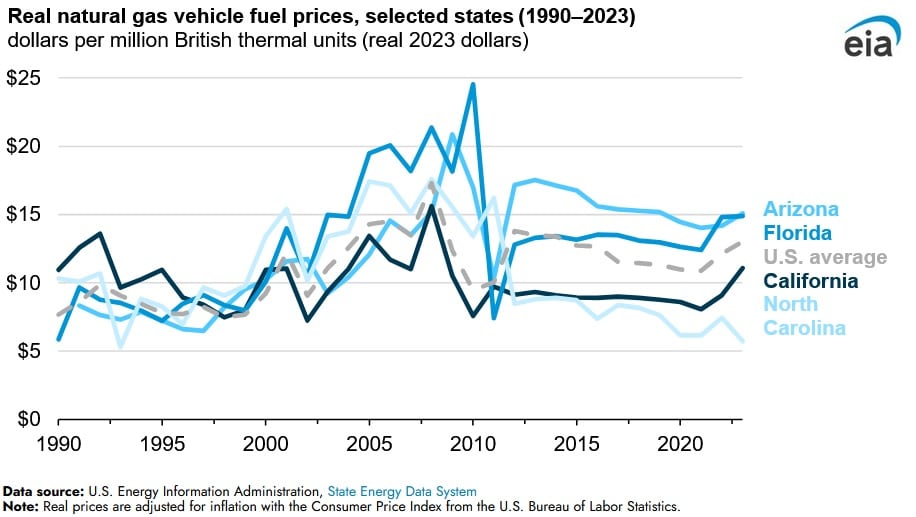Natural Gas Vehicle Fuel Prices Rise in Recent Years Following a Decade of Stability: EIA

Fuel prices for natural gas vehicles increased across 37 states between 2021 and 2023, but remained 25 percent lower than the peak during 2008, according to a Jan.14 report published by the U.S. Energy Information Administration. Real natural gas vehicle fuel prices were largely flat between 2011 and 2021.
Natural gas sold to the on-road vehicle fuel market in the U.S. more than doubled over the last 10 years from 30 billion cubic feet (Bcf) during 2023 to over 62 Bcf in 2023. A high number of U.S. natural gas powered vehicles are government agency owned fleet cars and buses. Majority of these vehicles utilize compressed natural gas for light, medium and heavy duty vehicles, while some bigger trucks utilize smaller volumes of liquefied natural gas (LNG). The main benefit of a natural gas powered vehicle in comparison to a diesel or gasoline powered vehicle is that natural gas prices are usually lower than petroleum products and are therefore cheaper to operate. Moreover, from an environmental perspective, natural gas releases lower carbon dioxide emissions than petroleum when combusted.
Natural gas vehicle fuel prices varied from a low of $5.73 per million British thermal units (MMBtu) in North Carolina and a high of $34.66/MMBtu in Rhode Island. Natural gas prices are impacted by a number of fundamentals, such as demand, supply, storage and weather. Moreover, prices over the last decade have been influenced by government regulation, as well as geopolitical tensions across the globe.
The state of California utilized the highest volumes of natural gas than in any other state in the U.S. every year on record since 1997, due to the high number of laws and incentives in the state for compressed natural gas and LNG. During 2023, California accounted for 51 percent of the U.S.’s market for natural gas vehicle fuel. The state with the second largest usage was Florida, which accounted for 10 percent. Moreover, no other state accounted for more than three percent during 2023. Natural gas vehicle fuel consumption in North Carolina increased at a higher rate than in any other state, increasing from 71 million cubic feet during 2013 to around 1.8 Bcf during 2023, in line with a number of state laws and incentives boosting the usage for compressed natural gas.
EnerKnol Pulses like this one are powered by the EnerKnol Platform—the first comprehensive database for real-time energy policy tracking. Sign up for a free trial below for access to key regulatory data and deep industry insights across the energy spectrum.
ACCESS FREE TRIAL